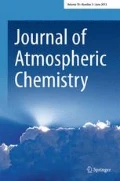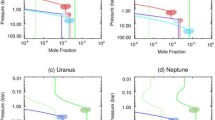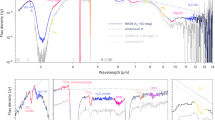Abstract
Specific studies about the stable isotope composition (18O/16O and D/H) of atmospheric icy conglomerations are still scarce. The present work offers, for the first time, a very detailed analysis of oxygen and hydrogen isotopic signatures of unusually large ice conglomerations, or “megacryometeors”, that fell to the ground in Spain during January 2000. The hydrochemical analysis is based on the bulk isotopic composition and systematic selective sampling (deuterium isotopic mapping) of eleven selected specimens. δ18O and δD (V-SMOW) of all samples fall into the Meteoric Water Line matching well with typical tropospheric values. The distribution of the samples on Craig's line suggests either a variation in condensation temperature and/or different residual fractions of water vapour (Rayleigh processes). Three of the largest megacryometeors exhibited unequivocally distinctive negative values (δ18O = −17.2%0 and δD = −127 %0 V-SMOW), (δ18O = −15.6%0 and δD = −112%0 V-SMOW) and (δ18O = −14.4%0 and δD = −100%0 V-SMOW), suggesting an atmospheric origin typical of the upper troposphere. Theoretical calculations indicate that the vertical trajectory of growth was lower than 3.2 km. During the period in which the fall of megacryometeors occurred, anomalous atmospheric conditions were observed to exist: a substantial lowering of the tropopause with a deep layer of saturated air below, ozone depression and strong wind shear. Moreover, these large ice conglomerations occurred during non-thunderstorm conditions, suggesting an alternative process of ice growth was responsible for their formation.
Similar content being viewed by others
References
AMS, 2000: Glossary of Meteorology, 2nd Edition, ISBN 1-878220-34-9, 850 pp.
BAMS, 2002: The sky is falling. News section V. 83, 12.
Beekmann, M., Ancelet, G., Blonsky, S., De Muer, D., Ebel, A., Elbern, H., Hendricks, J., Kowol-Santen, J., Mancier, C., Sladkovic, R., Smit, H. G. J., Speth, P., Tickl, T., and Van Haver, P., 1997: Regional and global tropopause fold occurrence and related ozone flux across the tropopause, J. Atmos. Chem. (28), 29–44.
Bertin, F., Campistron, B., Caccia, J. L., and Wilson, R., 2001: Mixing processes in a tropopause folding observed by a network of ST radar and lidar, Annales Geophysicae 19, 953–963.
Brink, K., Travis, D., and Martinez-Frías, J., 2003: Upper tropospheric conditions associated with recent clear-sky ice falls. 57th Annual Meeting, The Wisconsin Geographical Society, September 19–20, UW-Eau Claire.
Cohn, M. and Urey, H. C., 1938: Oxygen exchange reactions of organic compounds and water, J. Amer. Chem. Soc. 60, 679–687.
Coleman, M. L., Shepherd, T. J., Rouse, J. E., and Moore, G. R., 1982: Reduction of water with zinc for hydrogen isotope analysis, Anal. Chem. 54, 993–995.
Corliss, W. R., 1983: Ice falls or hydrometeors, in: W. R. Corliss (ed.), Tornados, Dark Days, Anomalous Precipitation and Related Weather Phenomena. A Catalogue of Geophysical Anomalies. The Sourcebook Project. P.O. Box 107, Glen Arm, MD 21057, pp. 40–44.
Craig, H., 1961: Isotopic variations in meteoric waters, Science 133, 1702–1703.
Dansgaard, W., 1964: Stable isotopes in precipitation, Tellus 16-5, 461–469.
Dansgaard, W., Johnsen, S. J., Clauson, H. B., Dahl-Jensen, D., Gundestrup, N. S., Hammer, C. U., Hvidberg, C. S., Steffensen, J. P., Sveinbjornsdottir, A. E., Jouzel, J., and Bond G., 1993: Evidence for general instability in past climate from a 250 kyr ice-core record, Nature 364, 218–220.
Diamond, R. E. and Harris, C., 1997: Oxygen and hydrogen isotope composition of Western Cape meteoric water, S. Afr. J. Sci. 93, 371–374.
Ebel, A. Feldmann, H., Offermann, D., and Schäler, B., 2000: Meso-scale studies of composition and transport in the tropopause region, AFO2000 Newsletter 2, 7–10.
Ehhalt, D., 1974: Vertical profiles of HTO, HDO, and H2O in the troposphere, NCAR, Natl. Cent. for Atmos. Res., Boulder, Colo. Tech. Note NCAR/-TN/STR-100, 131 pp.
Epstein, S. and Mayeda, T. K. 1953: Variation of the 18O/16O ratio in natural waters, Geochim. Cosmochim. Acta 4, 213–224.
Facy, L., Merlivat, L., Nief, G. and Roth, E. 1963: The study of the formation of a hail-stone by means of isotopic analysis, J. Geophys. Res. 68, 3841–3848.
Federer, B., Brichet, N., and Jouzel, J., 1982a: Stable isotopes in hailstones 1. The isotopic cloud model, J. Atmos. Sci. 39-6, 1323–1335.
Federer, B., Thalmann, B., and Jouzel, J., 1982b: Stable isotopes in hailstones 2. Embryo and hailstone growth in different storms, J. Atmos. Sci. 39-6, 1336–1355.
Foot, R. and Mitra, S., 2002: Ordinary atom-mirror atom bound states: A new window on the mirror world, Phys. Rev. D 66, 061301.
Friedman, I., 1953: Deuterium content of natural water and other substances, Geochim. Cosmochim. Acta 4, 89–103.
Gedzelman, S. D. and Arnold, R., 1994: Modeling the isotopic composition of precipitation, J. Geophys. Res. 99, 10455–10571.
Griffiths, R. F., 1975: Observation and analysis of an ice hydrometeor of extraordinary size, Met. Mag. 104, 253–260.
GWC, 2004: Gungahlin Weather Centre http://members.optusnet.com.au/darrengiles/articles/factsandfigures.htm.
He, H. and Smith, R. B., 1999: Stable isotope composition of water vapor in the atmospheric boundary layer above the forests of New England, J. Geophys. Res-Atmospheres 104, 11657–11673.
Hirschberg, P. A. and Fritsch, J. M., 1991: Tropopause undulations and the development of extratropical cyclones: Part II: Diagnostic analysis and conceptual model, Mon. Weat. Rev. 119, 518-550.
Illingworth, A., 1989: Growth of large hailstones, Nature 337 (6209), 691–691.
Jacob, H. and Sonntag, C., 1991: An 8-year record of the seasonal variation of 2H and 18O in atmospheric water vapour and precipitation at Heidelberg, Germany. Tellus 43B, 291–300.
Jouzel, J., Merlivat, L., and Roth, E., 1975: Isotopic study of hail, J. Geophys. Res. 80, 5015–5030.
Jouzel, J., Merlivat, L., and Federer, B., 1985: Isotopic study of hail – the delta-D-delta-O-18 relationship and the growth history of large hailstones, Q. J. Roy. Meteor. Soc. 111, 495–516.
Leigh, R., 1999: The April 1999 Sydney Hailstorm, Natural Hazard Quaterly 5, 2.
Martínez-Frías, J. and López-Vera, F., 2000: Los bloques de hielo que caen del cielo. Antecedentes y fenomenología reciente, Rev. Ens. Cien. Tierra. 8-2, 130–136.
Martínez-Frías, J., López-Vera, F., García, N., Delgado, A., García, R., and Montero, P., 2000: Hailstones fall from clear Spanish skies, News Notes Geotimes 45–6, 11.
Martínez-Frías, J. and Travis, D., 2002: Megacryometeors: Fall of atmospheric ice blocks from ancient to modern times, in: S. Leroy and I. S. Stewart (eds.), Environmental Catastrophes and Recovery in the Holocene. Abstracts Volume. Brunel University, West London (UK), pp. 54–55.
Martínez-Frías, J., Millán, M., García, N., López-Vera, F., Delgado, A., García, R., Rodríguez-Losada, J. A., Reyes, E., Martín Rubí, J. A., and Gómez-Coedo, A., 2001: Compositional heterogeneity of hailstones: Atmospheric conditions and possible environmental implications, Ambio. 30-7, 452–455.
Martinez-Frias, J. and Rodríguez-Losada, J. A., 2004: Atmospheric megacryometeor events versus small meteorite impacts: Scientific and human perspective of a potential natural hazard. International Council for Science (ICSU) Workshop: Comet/asteroid impacts and human society, November 27–December 2, 2004 Santa Cruz de Tenerife, Tenerife, Canary Islands (Spain) (abstract).
McGuffie, K. and Henderson-Selle, A., 2004: Stable water isotope characterization of human and natural impacts on land-atmosphere exchanges in the Amazon Basin, Journal of Geophysical Research 109, 1–25.
Merlivat, L. and Nief, G., 1967: Isotopic fractionation of the solid-vapor and liquid-vapor changes of state of water a temperatures below 0 ∘C, Tellus 19, 122–127.
Moreira, M. Z., Sternberg, L. S. L., Martinelli, L. A., Victoria, R. L., Barbosa, E. M., Borates, C. M., and Nepstads, A. C., 1997: Contribution of transpiration to forest ambient vapour based on isotopic measurements, Global Change Biology 3, 439–450.
Munoz, R., 2000: Hail. Fact Sheet. http://www.ucar.edu/communications/factsheets/Hail.html
National Weather Service Forecast Office, NWSFO, 2002: What about hail? NOAA http://tgsv5.nws.noaa.gov/er/box/hail.html
Oltmans, S. J. and Hofmann, D. J. 1995: Increase in lower-stratosphere water vapour at a mid-latitude Northern Hemisphere site from 1981 to 1994, Nature 374, 146–149.
Ovarlez, J., Velthoven, P., and Schlager, H., 1999: Water vapor measurements from the troposphere to the lowermost stratosphere: Some signatures of troposphere to stratosphere exchanges, J. Geophys. Res. 104, 16973–16978.
Park, C. B. and Lee, C. H., 2001: Tropopause folding effect on Ozone Observation measured by Lidar and sonde over Suwon station, NDSC 2001 Symposium, September (Arcachon, France).
Raya, J., 2003: Composición isotópica del vapor de agua atmosférico en el Sureste de la Península Ibérica, Doctoral Thesis Univ. Granada. 418 pp.
Roelofs, G. J., Kentarchos, A. S., Trickl, T., Stohl, A., Collins, W. J., Crowther, R. A., Hauglustaine, D., Klonecki, A., Law, K. S., Lawrence, M. G., von Kuhlmann, R., and van Weele, M., 2003: Intercomparison of tropospheric ozone models: ozone transports in a complex tropopause folding event. J. Geophys. Res. (abstract) http://www.phys.uu.nl/roelofs/werk/abstracts_files/abstract10.html
Rozanski, K., Araguás, L., and Gonfiantini, R., 1993: Isotopic patterns in modern global precipitation, in: Climatic Change in Continental Isotopic Records (AGU) Geophysical Monograph 78 pp. 1-36.
Santoyo, E., García, R., Martínez-Frías, J., López-Vera, F., and Verma, S. P., 2002: Capillary Electrophoretic analysis of inorganic anions in atmospheric hailstone samples, Journal Chromatography A 956, 279–286.
Santer, B. D., Wehner, M. F., Wigley, T. M.L., Sausen, R., Meehl, G. A., Taylor, K. E., Ammann, C., Arblaster, J., Washington, W. M., Boyle, J. S., and Brüggemann, W., 2003: Contributions of anthropogenic and natural forcing to recent tropopause height changes, Science 301, 479–483.
Souchez, R. A., Jouzel, J., Lorrain, R., Sleewaegen, S., Stievenard, M., and Verbeke, V., 2000: A kinetic isotope effect during ice formation by water freezing, Geoph. Res. Letters 27-13, 1923–1926.
Sturman, A. P. and Tapper, N., 1996: The Weather and Climate of Australia and New Zealand (Oxford, UK) 476 p.
Taylor, C. B., 1972: The vertical variations of isotopic composition of tropospheric water vapour over continental Europe and their relations to tropospheric structure, Inst. Nucl. Sci. Report. ISN-R-107, 45 pp. Lower Hutt, New Zealand.
Taylor, C. B., 1984: Vertical-distribution of deuterium in atmospheric water-vapor: Problems in application to assess atmospheric condensation models, Tellus (Series B) 36B, 67–70.
Thompson, L. G., Mosley-Thompson, E., Davis, M. E., Lin, P. N., Henderson, K. A., Cole-Dai, J., Bolzan, J. F., and Liu, K. B. 1995: Late glacial stage and holocene tropical ice core records from Huascarán, Peru, Science 269, 46–50.
Thompson, L. G. T., Yao, T., Thompson, E., Davis, M. E., Henderson, K. A., and Lin, P.-N., 2000, Sep 15: A High-Resolution Millennial Record of the Monsoon from Himalayan Ice Cores, Science pp. 1916–1919.
Wimmers, A. J. and Moody, J. L., 2003: Calibration of GOES water vapor spatial gradients with tropopause folding events, American Meteorological Society Annual Meeting. Abstract. P2.31.
Zahn, A., Barth, V., Pfeilsticker, K., and Platt, U., 1998: Deuterium, oxygen-18, and tritium as tracers for water vapour transport in the lower stratosphere and tropopause region, J. Atmospheric Chem. 30, 25–47.
Author information
Authors and Affiliations
Corresponding author
Rights and permissions
About this article
Cite this article
Martinez-FrÍAs, J., Delgado, A., MillÁN, M. et al. Oxygen and Hydrogen Isotopic Signatures of Large Atmospheric Ice Conglomerations. J Atmos Chem 52, 185–202 (2005). https://doi.org/10.1007/s10874-005-2007-7
Received:
Accepted:
Issue Date:
DOI: https://doi.org/10.1007/s10874-005-2007-7




